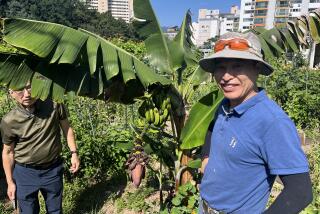Number of Ginseng Growers Withering
- Share via
KANGHWA, South Korea — For most of his 80 years, Lee Bong-Hee has roamed dark regions of Korea’s tough hills, looking for shady, rocky patches suitable for planting ginseng.
The root is fabled in Asia for its ability to promote health and vitality, but it is a tough crop to grow.
“It all starts with finding the right type of soil,” Lee says.
Lee and others of his age wonder how much longer their countrymen will be willing to engage in the generations-old search. Only 20,000 to 24,000 ginseng growers are left in South Korea.
“Children are not taking over. We send them to universities, and they don’t come back,” says Hwang In-Chul, an official of a ginseng growers cooperative on Kangwha, an island northwest of Seoul.
Little wonder, considering the intensive work required to grow ginseng, a sweet but bitter-tasting root that has fascinated Asians for centuries because of its supposed medicinal properties.
Korea was the first recorded nation to cultivate ginseng and boasts its variety is superior to any other. Believing the root is a cure-all for everything from a common cold to a sagging libido, Koreans consume it in tea, tablets and food.
A fifth-century Chinese medical book says: “Ginseng . . . evens the spirits, allays fear, improves the eyesight, sharpens the memory, removes thirst, and if taken for a while, invigorates the body and prolongs life.”
Strong demand and the toughness of bringing in a crop means the rewards can be considerable for those willing to spend the time and effort.
Ginseng sells for the equivalent of $60 a pound, and an acre of the right kind of loamy, rocky, heavily shaded and well-drained land on a mountain slope can produce 3,300 pounds, worth $198,000.
But that prized acre will produce only one crop every 17 years.
“Ginseng farming is such a gamble,” says Lee, who has grown ginseng as a full-time occupation for 45 years. “When city people drive by and see ginseng, they see money. They don’t see what’s behind all that.”
Ginseng is extremely vulnerable to fungus and root rot. Exposure to direct sunlight is fatal to the plant, so it must be planted in fields that get sunlight only at dawn and sunset. Farmers must enclose their plots with snares and traps to protect the crop from pests and thieves.
It takes 18 months to grow ginseng seedlings. After transplanting, half of the seedlings will die or rot before producing the most coveted 7-year-old root.
Then, because Asians believe ginseng absorbs its medicinal powers from the ground, farmers leave plots dormant for a decade before planting more ginseng. Even after the rest, the used ground never produces the same quality, they say.
Ginseng--”man-shaped root” in Korean--just might have some of the powers attributed to it by its admirers, Asian experts say.
“More of the purported curative powers of ginseng, including its anti-impotence effect, are supported by laboratory testing,” says Dr. Choi Hyong-Ki of Yonsei University’s Severance Hospital.
More to Read
Sign up for Essential California
The most important California stories and recommendations in your inbox every morning.
You may occasionally receive promotional content from the Los Angeles Times.













